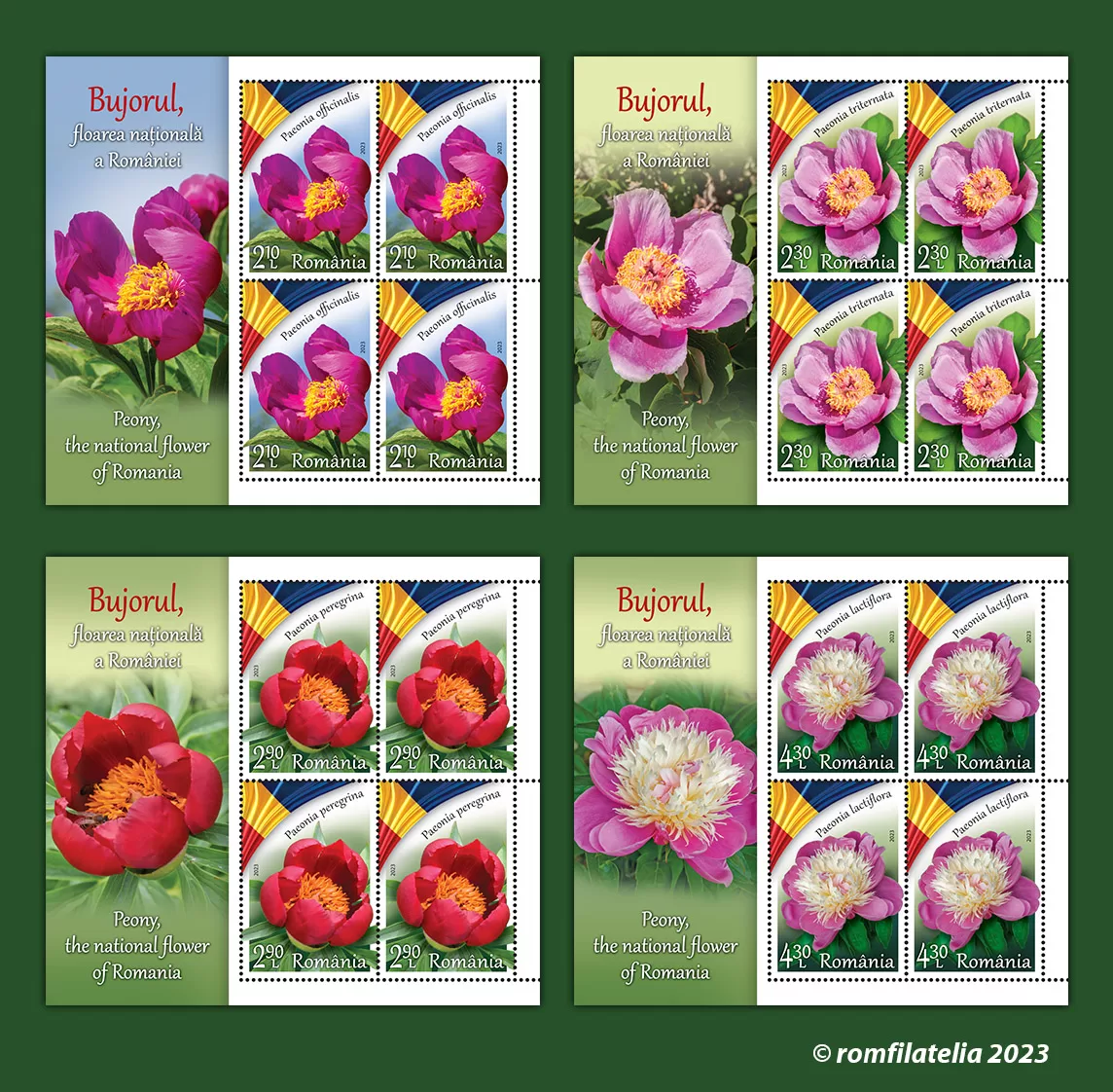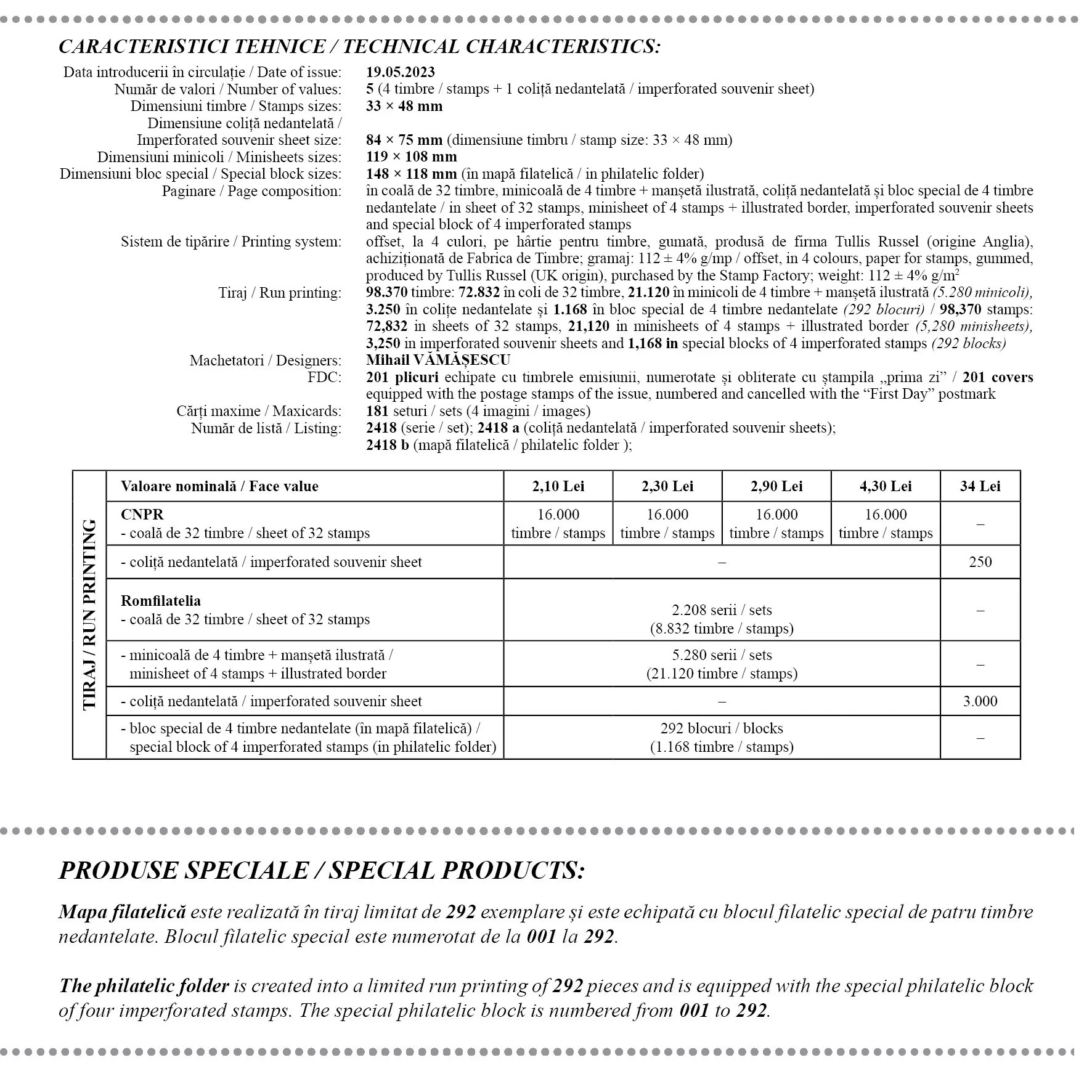 Romfilatelia introduces into circulation on Friday, May 19th this year, the issue of postage stamps entitled „Peony, the national flower of Romania”, a theme of interest for collectors, but also out of a desire to promote the country’s floral symbol in the category of elements of national identity.
Romfilatelia introduces into circulation on Friday, May 19th this year, the issue of postage stamps entitled „Peony, the national flower of Romania”, a theme of interest for collectors, but also out of a desire to promote the country’s floral symbol in the category of elements of national identity.
There is almost no park or garden in Romania where we do not find it cultivate at least one peony bush, few species can still “boast” such a popularity. The peony stands for the floral emblem of Romania, which, following the initiative of the Faculty of Horticulture of USAMV (University of Agronomic Sciences and Veterinary Medicine) of Bucharest, on October 26th, 2022, became the Law no. 285/2022, through which the peony flower was officially declared the national flower of Romania.
Peony (Paeonia officinalis L. subsp. Officinalis) illustrated on the stamp with the face value of Lei 2.10. Synonyms: peony; rușoara; bujor, mac; bujor, băbărujă, bajoroji, bajaruji, bojor, bonjur (Breaza), buja, bujoară, white peony, garden peony, red peony, little peony, bușor, râjioară, roză de Rusalii, roza, roșioară, ruj, rujă, rujă bujă, rujă bujă roșie, rujă de Rusalii, rujambujă, rujă roșie, ruje, ruji mari, rujioară, rușii de Rusalii, rușioară, rușoară, tubarojă, tubaroză. It is a species native to central, southern and western Europe.
The plant forms a dense bush with a height and diameter of 40-60 cm. The leaves are large, pinnately sectioned with lanceolate leaflets. The flowers are 10-12 cm in diameter, unscented, single or double, coloured in various shades of red or pink. The blooming: May, beginning of June.
Peony (Paeonia triternata Pall.) depicted on the stamp with the face value of Lei 2.30. Spread in the country: gorun plateau, on sunny slopes, sparse forests, in Mehedinți county (Vârciorova, on Ciocanu Mountain) and Buzău county (Salcia on Plaiul Sărății, Ciolanu Monastery, on Poiana Rotunda Hill). Leaves 2-3 times pinnately-sectioned, with broader segments, the segments subrounded, with wavy margins, pink flowers with yellow stamens. The blooming: May-June.
Forest peony (Paeonia peregrina Mill.) represented on the stamp with the face value of 2,90 Lei. Synonyms: Romanian peony, peony, ruje, ruje-de-Rusalii, rujioară, mountain peony, smirdar. Country distribution: steppe area of oak forests, glades, forest edges. The plant has 2-3 times pinnately sectioned leaves with + lanceolate segments, red petalled flowers with red staminal filaments and flowering in May-June. It is a plant protected by law: it must not be destroyed or collected. „Do not destroy the world’s corolla of wonders” (Lucian Blaga).
Common or herbaceous peony (Paeonia lactiflora Pall., synonym P. albiflora Pall.) depicted on the stamp with the face value of Lei 4.30 is native to China and has hundreds of cultivars. The epithet lactiflora means „with white milk flowers”. The plant is 60-100 cm in height and diameter. The stems are branched in the upper third. The leaves are pinnately sectioned with lanceolate leaflets. The flowers are large, single or double, fragrant, coloured in various shades of pink, red or white, blooming in May-June and some cultivars even in July. The roots of the plant have been used for over 1000 years in Chinese medicine.
Steppe peony (Paeonia tenuifolia L.) illustrated on the imperforated souvenir sheet of the issue having the stamp with the face value of Lei 34. Synonyms: babaruje, bojorojii, roșioară, ruja-buja; field peony, peony. The species is also known as “fernleaf” peony. The plant was first described by the Swedish botanist Carl Linné. Country distribution: steppe area of oak forests in sunny meadows. The plant has 2-3 times pinnately-sectioned leaves with linear segments, flowers with red petals and yellow stamens. The blooming: April – May.
Romfilatelia thanks the specialists from the Faculty of Horticulture of the University of Agronomic Sciences and Veterinary Medicine for their documentary support in the production of this issue of postage stamps.



